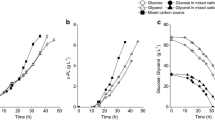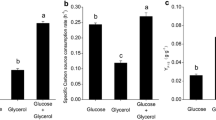Abstract
A glucose–glycerol mixed carbon source (MCS) can substantially reduce batch fermentation time and improve ε-poly-l-lysine (ε-PL) productivity, which was of great significance in industrial microbial fermentation. This study aims to disclose the physiological mechanism by transcriptome analyses. In the MCS, the enhancements of gene transcription mainly emerged in central carbon metabolism, l-lysine synthesis as well as cell respiration, and these results were subsequently proved by quantitative real-time PCR assay. Intracellular l-lysine determination and exhaust gas analysis further confirmed the huge precursor l-lysine pool and active cell respiration in the MCS. Interestingly, in the MCS, pls was remarkably up-regulated than those in single carbon sources without transcriptional improvement of HrdD, which indicated that the improved ε-PL productivity was supported by other regulators rather than hrdD. This study exposed the physiological basis of the improved ε-PL productivity in the MCS, which provided references for studies on other biochemicals production using multiple substrates.







Similar content being viewed by others
References
Shukla SC, Singh A, Pandey AK, Mishra A (2012) Review on production and medical applications of ɛ-polylysine. Biochem Eng J 65:70–81
Hiraki J, Ichikawa T, Ninomiya S, Seki H, Uohama K, Seki H, Kimurad S, Yanagimoto Y, Barnett JW Jr (2003) Use of ADME studies to confirm the safety of ε-polylysine as a preservative in food. Regul Toxicol Pharmacol 37:328–340
Shih IL, Shen MH, Van YT (2006) Microbial synthesis of poly(epsilon-lysine) and its various applications. Bioresour Technol 97:1148–1159
Li S, Tang L, Chen XS, Liao LJ, Li F, Mao ZG (2011) Isolation and characterization of a novel epsilon-poly-l-lysine producing strain: Streptomyces griseofuscus. J Ind Microbiol Biotechnol 38:557–563
Bankar SB, Singhal RS (2010) Optimization of poly-epsilon-lysine production by Streptomyces noursei NRRL 5126. Bioresour Technol 101:8370–8375
Jia S, Wang G, Sun Y, Tan Z (2009) Improvement of ε-poly-l-lysine production by Streptomyces albulus TUST2 employing a feeding strategy, in 3rd International Conference on Bioinformatics and Biomedical Engineering, Tianjin University of Science and Technology, Tianjin, China, Beijing. https://doi.org/10.1109/ICBBE.2009.5162940
Xia J, Xu Z, Xu H, Feng X, Bo F (2014) The regulatory effect of citric acid on the co-production of poly (ε-lysine) and poly (l-diaminopropionic acid) in Streptomyces albulus PD-1. Bioprocess Biosyst Eng 37:2095–2103
Xu Z, Bo F, Xia J, Sun Z, Li S, Feng X, Xu H (2015) Effects of oxygen-vectors on the synthesis of epsilon-poly-lysine and the metabolic characterization of Streptomyces albulus PD-1. Biochem Eng J 94:58–64
Liu S, Wu Q, Zhang J, Mo S (2011) Production of epsilon-poly-l-lysine by Streptomyces sp. using resin-based, in situ product removal. Biotechnol Lett 33:1581–1585
Zhang Y, Feng X, Xu H, Yao Z, Ouyang P (2010) Epsilon-poly-l-lysine production by immobilized cells of Kitasatospora sp. MY 5–36 in repeated fed-batch cultures. Bioresour Technol 101:5523–5527
Shih IL, Shen MH (2006) Optimization of cell growth and poly(ɛ-lysine) production in batch and fed-batch cultures by Streptomyces albulus IFO14147. Process Biochem 41:1644–1649
Kahar P, Iwata T, Hiraki J, Park EY, Okabe M (2001) Enhancement of ε-polylysine production by Streptomyces albulus strain 410 using pH control. J Biosic Bioeng 91:190–194
Chen XS, Tang L, Li S, Liao LJ, Zhang JH, Mao ZG (2011) Optimization of medium for enhancement of epsilon-poly-l-lysine production by Streptomyces sp. M-Z18 with glycerol as carbon source. Bioresour Technol 102:1727–1732
Chen XS, Mao ZG (2013) Comparison of glucose and glycerol as carbon sources for epsilon-poly-l-lysine production by Streptomyces sp. M-Z18. Appl Biochem Biotechnol 170:185–197
Chen XS, Ren XD, Dong N, Li S, Li F, Zhao FL, Tang L, Zhang JH, Mao ZG (2012) Culture medium containing glucose and glycerol as a mixed carbon source improves ε-poly-l-lysine production by Streptomyces sp. M-Z18. Bioprocess Biosyst Eng 35:469–475
Kim YS, Lee JH, Kim NH, Yeom SJ, Kim SW, Oh DK (2011) Increase of lycopene production by supplementing auxiliary carbon sources in metabolically engineered Escherichia coli. Appl Microbiol Biotechnol 90:489–497
Liu Y, Zhang YG, Zhang RB, Zhang F, Zhu J (2011) Glycerol/glucose co-fermentation: one more proficient process to produce propionic acid by Propionibacterium acidipropionici. Curr Microbiol 62:152–158
Peacock L, Ward J, Ratledge C, Dickinson F, Ison A (2003) How Streptomyces lividans uses oils and sugars as mixed substrates? Enzyme Microb Technol 1:157–166
Liao G, Liu Q, Xie J (2013) Transcriptional analysis of the effect of exogenous decanoic acid stress on Streptomyces roseosporus. Microb Cell Fact 12:1–7
Redon E, Loubiere P, Cocaign-Bousquet M (2005) Transcriptome analysis of the progressive adaptation of Lactococcus lactis to carbon starvation. J Bacteriol 187:3589–3592
Sakurai K, Arai H, Ishii M, Igarashi Y (2011) Transcriptome response to different carbon sources in Acetobacter aceti. Microbiology-GSM 157:899–910
Godard P, Urrestarazu A, Vissers S, Kontos K, Bontempi G, van Helden J, André B (2007) Effect of 21 different nitrogen sources on global gene expression in the yeast Saccharomyces cerevisiae. Mol Cell Biol 27:3065–3086
Nishikawa M, Ogawa K (2002) Distribution of microbes producing antimicrobial ε-poly-l-lysine polymers in soil microflora determined by a novel method. Appl Environ Microbiol 68:3575–3581
Fountoulakis M, Lahm HW (1998) Hydrolysis and amino acid composition analysis of proteins. J Chromatogr A 826:109–134
Ren XD, Chen XS, Tang L, Zeng X, Wang L, Mao ZG (2015) Physiological mechanism of the overproduction of ε-poly-l-lysine by acidic pH shock in fed-batch fermentation. Bioprocess Biosyst Eng 38:2085–2094
Zeng X, Chen XS, Ren XD, Liu QR, Wang L, Sun QX, Tang L, Mao ZG (2014) Insights into the role of glucose and glycerol as a mixed carbon source in the improvement of ε-poly-l-lysine productivity. Appl Biochem Biotechnol 173:2211–2224
Yamanaka K, Maruyama C, Takagi H, Hamano Y (2008) Epsilon-poly-l-lysine dispersity is controlled by a highly unusual nonribosomal peptide synthetase. Nat Chem Biol 4:766–772
Wang L, Gao C, Tang N, Hu S, Wu Q (2015) Identification of genetic variations associated with epsilon-poly-lysine biosynthesis in Streptomyces albulus ZPM by genome sequencing. Sci Rep UK 5:9201
Hamano Y, Yoshida T, Kito M, Nakamori S, Nagasawa T, Takagi H (2006) Biological function of the pld gene product that degrades epsilon-poly-l-lysine in Streptomyces albulus. Appl Microbiol Biotechnol 72:173–181
Yamanaka K, Kito N, Imokawa Y, Maruyama C, Utagawa T, Hamano Y (2010) Mechanism of epsilon-poly-l-lysine production and accumulation revealed by identification and analysis of an epsilon-poly-l-lysine-degrading enzyme. Appl Environ Microbiol 76:5669–5675
Zhang JH, Zeng X, Chen XS, Mao ZG (2018) Metabolic analyses of the improved ε-poly-l-lysine productivity using a glucose–glycerol mixed carbon source in chemostat cultures. Bioprocess Biosyst Eng. https://doi.org/10.1007/s00449-018-1943-y
Rao YM, Sureshkumar GK (2001) Improvement in bioreactor productivities using free radicals: HOCl-induced overproduction of xanthan gum from Xanthomonas campestris and its mechanism. Biotechnol Bioeng 72:62–68
Wei ZH, Bai LQ, Deng ZX, Zhong JJ (2011) Enhanced production of validamycin A by H2O2-induced reactive oxygen species in fermentation of Streptomyces hygroscopicus 5008. Bioresour Technol 102:1783–1787
Zeng X, Chen XS, Gao Y, Ren XD, Wang L, Mao ZG (2015) Continuously high reactive oxygen species generation decreased the specific ε-poly-L-lysine formation rate in fed-batch fermentation using glucose and glycerol as a mixed carbon source. Process Biochem 50:1993–2003
Acknowledgements
This work was financially supported by the National Natural Science Foundation of China (31671846, 31301556), the Science and Technology Department of Jiangsu Province (BY2016022-25), the Open Project Program of the Key Laboratory of Industrial Biotechnology, Ministry of Education, China (KLIBKF201302), the Jiangsu Province Collaborative Innovation Center for Advanced Industrial Fermentation Industry Development Program and the Innovation Team of Scientific Research Platform of Anhui Province, China (KJ2015TD001) and China Postdoctoral Science Foundation (2018M632962).
Author information
Authors and Affiliations
Corresponding authors
Ethics declarations
Conflict of interest
The authors declare that they have no competing interests.
Additional information
Publisher’s Note
Springer Nature remains neutral with regard to jurisdictional claims in published maps and institutional affiliations.
Electronic supplementary material
Below is the link to the electronic supplementary material.
Rights and permissions
About this article
Cite this article
Zeng, X., Miao, W., Wen, B. et al. Transcriptional study of the enhanced ε-poly-l-lysine productivity in culture using glucose and glycerol as a mixed carbon source. Bioprocess Biosyst Eng 42, 555–566 (2019). https://doi.org/10.1007/s00449-018-2058-1
Received:
Accepted:
Published:
Issue Date:
DOI: https://doi.org/10.1007/s00449-018-2058-1




